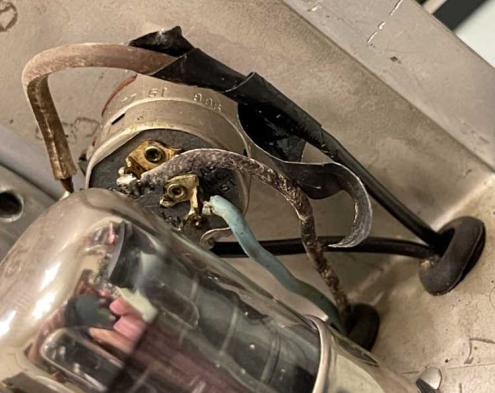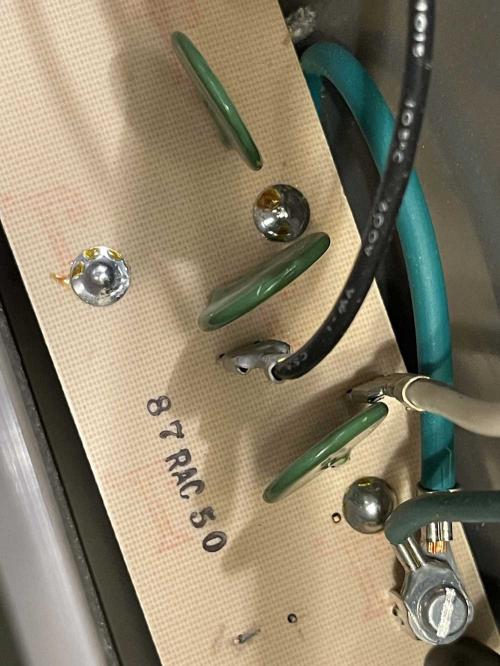- 2023
- Jun
- 27
Checking out an Eico 145 Signal Tracer
This is an Eico 145 Signal Tracer that I picked up at the Breezeshooters’ Hamfest in Butler, PA. I didn’t really need it, but the gentleman that was selling it only had a few bucks on it, so why not? This is basically a test amplifier, replacement speaker, and a replacement output transformer for troubleshooting radio and other basic consumer electronics from the vacuum tube era.
Tube compliment is:
6X5 dual diode rectifier
6SJ7 pentode as the audio preamp
6K6 pentode as the audio power amp
All the tubes for this device are octal. Later models used miniature tubes.
The unit has multiple manufacturers present in the tube lineup, so this thing probably saw a fair bit of use during it’s day. Counterclockwise from the left, it’s GE, RCA, and Sylvania, although the RCA and Sylvania tubes both exhibit the octagonal tube number symbol that indicate they were made by RCA. You can’t trust the label on these things, every manufacturer made things for every other manufacturer!
The front panel is in well-used condition, with a spray of bronze paint across the top. Was someone trying to repaint another piece of Eico gear with that sandalwood-bronze paint they liked to use?
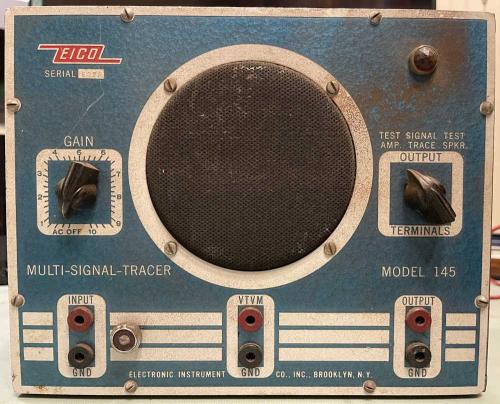
The top is rusty-ish, more so that the rest of the chassis. Perhaps it was someplace damp enough that water condensed on the top due to temperature differentials? Who knows. The handle is in excellent condition, and present - always a plus for these units.
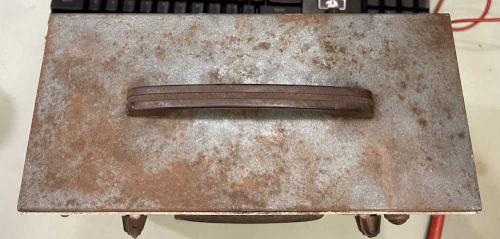
Chassis isn’t in too bad of condition, although there are definite signs of repairs and modifications along the way, especially the jack that’s been added to the front to allow a later model signal tracer’s RF probe to be used with this device.
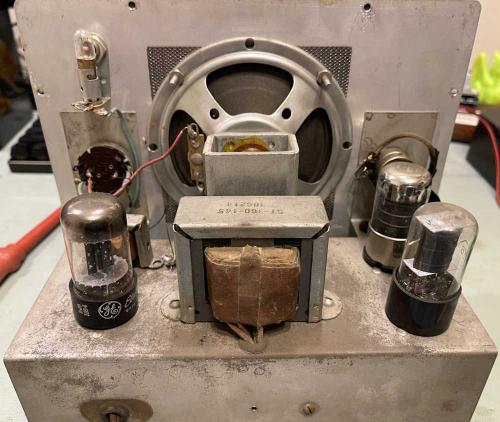
The bottom of the unit was in acceptable condition. This unit was most likely built by the end user. It’s put together in a decent manner, but is a bit of routing and soldering here and there that reveal it was built by a non-professional. That’s not an issue, it’s worked this long. (You could buy these pre-built by the factory or you could do it yourself.)
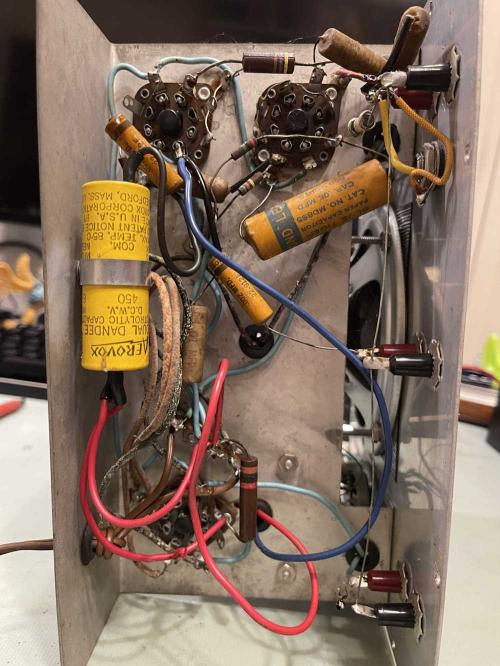
There were some parts just floating around in the chassis, including two wax capacitors for the input. These just went up through the chassis and connected to repaired wires near the function selection switch. They may be original, but have been touched at some point in their life. Note also the across-the-line capacitor (800V 0.05uF) and the added jack for the later RF probe.
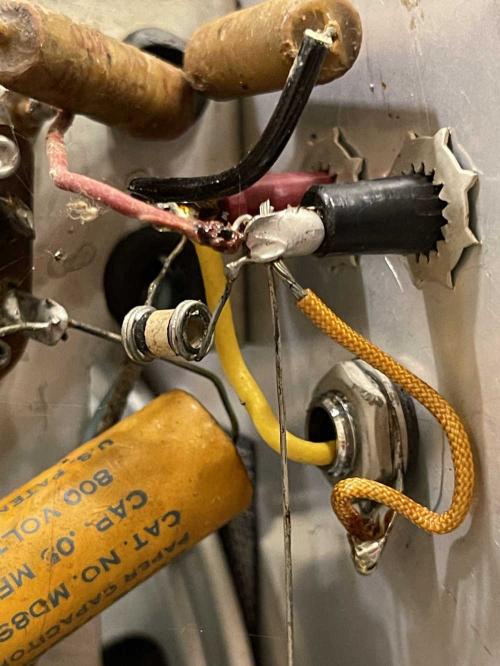
There was some burnt insulation suggesting a soldering iron had been a little careless over the years. That needs to be replaced or covered at some point, but since that’s part of the electrolytic assembly it will probably just get replaced. The electrolytic itself appears to be a replacement, as the soldering job is different (and messier) than the other joints.
One I noted here was the black cloth-coated wire running up to the top of the tube socket. This has a cold joint with enough mechanical connection to make it work. How long has this been like it is? Probably since it was built. That needs to be cleaned up and fixed if this device is ever going into use.
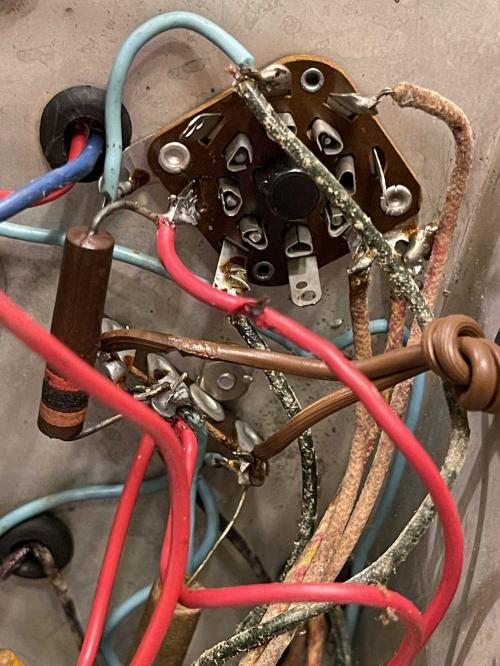
Since there’s no obvious shorts, and a quick check of the capacitors didn’t reveal anything unusual, I decided to give it the ‘ol Brute Force Reform, aka just plug it in (to a fused socket of course!) After a bit of warmup, I have light!
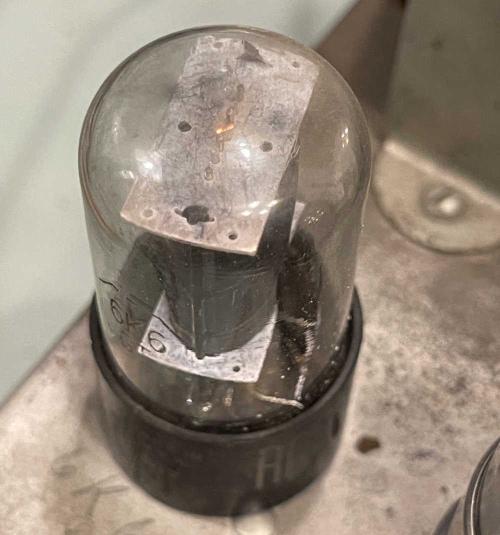
There’s no hum or excessive noise, so the device is still functional. I applied a 1KHz signal to the input, set it to Trace, and yep. It works fine. Sounds just a bit ragged, so there may be something wrong, or perhaps my cheap well used signal generator needs some work. But everything important here is operational, tubes, transformers, switches. The rest can be replaced if need be.
This gets buttoned up and is now awaiting a few minor replacements before going into use as-is. Nothing like a battle-scarred piece of equipment on your desk!
This is going to take more than minor replacements…check the next part of this series!
Next part of this series: https://wereboar.com … ignal-tracer-part-0/
- 2023
- Jun
- 23
Random board shot: AT&T PBX Surge Suppressor
This board containing a rather simplistic transient suppression circuit is the “AT&T Model 145 Transient Voltage Surge Protector” - nothing more than 3 Metal-Oxide Varistors of the same kind you’d find in a cheap power strip from the discount store. I suppose the giant box the thing is in and the red lamp on the front make up for the fact that this thing isn’t going to do diddle other than make some (contained) fire in an emergency. There’s no other filtering, and MOVs are a one-and-done device.
These were provided with AT&T network equipment, in this case a Merlin 820D2 4 line to 20 phone commercial PBX. I can’t complain, however, the device this protected was just recently turned off. Ma Bell made it to last 40 years, and it pretty much got there.
That’s not why I’m posting this, however. Of note is the orange Textolite “T”, once again indicating how far the GE Coshocton manufacturing plant reached over the years.
Another reminder of the past packed in a little box.
- 2023
- Jun
- 22
This little werepig has settled in his new home.
Originally, I thought I’d keep pygg.xyz duplicated with the same content as my new home, but really, when it comes down to it, there’s no reason for that. A simple redirect in the website’s code will automagically bring people to my new home. You’ll land on the project page since that’s where the good stuff lives.
So, take a look around. You’ll find everything pretty much looks the same. You can even replace the pygg.xyz in any URL you find with wereboar.com, and it will take you to the exact spot you were looking for. (For the most part, I’ve trimmed a bit here and there to make for a leaner piggy!)
If you landed here looking for the homepage, click this link to go there: https://wereboar.com/
Thanks for stopping by. Hope you enjoy the slice of unusual that I find in the electronics world.
- Bryan
- 2023
- Jun
- 19
I didn’t drag home much stuff from Butler, but…
As usual, a few boat anchors made their way into my car. How does this keep happening?
The club presenting the show had a booth where they sold things from estates and donations. I picked up a stack of books for a few dollars. I have one of these already, so it’s going to go to a friend who said “Cool! Analog circuits in an analog storage medium!”

Another vendor had a bunch of parts in a box. Lots of radio shack things, sadly the “1N34A” diode packs were all empty. Nonetheless, I walked away with a handful of stuff for a few bucks. I have no idea what to do with the touch-tone decoder other than keep it as a collectible…
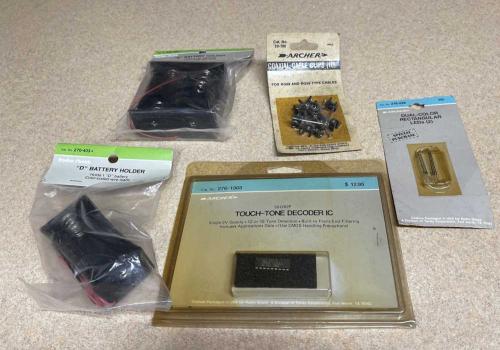
These two anchors were $20 for the pair (from different vendors of course.) The audio test amp was from an older gentleman that looked as if he was cleaning things out - he had a capacitor tester I should have grabbed as well. The generator was from a latecomer, and I bought it because of the information on the side of the device.
The audio test amp turned on and lit up, but had no audio output, not even a hum when the inputs were touched. A quick examination inside revealed some bad repairs and some potential issues with the original assembly - this will be the subject of another post later this month. The generator - who knows. I didn’t get around to trying it out yet.
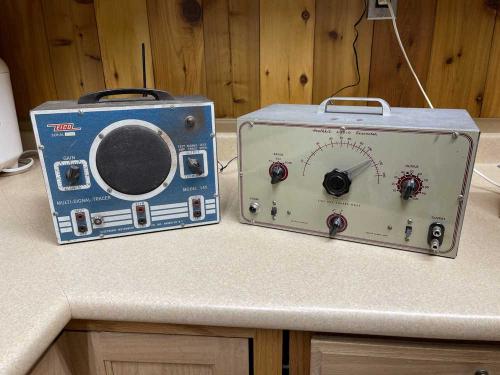
The signal generator had apparently sat in a rack at a General Telephone central office. That was cool enough for me to bring it home, even if it doesn’t work.
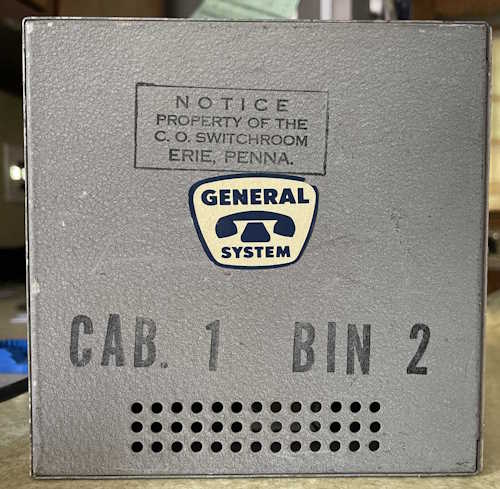
That’s all from the Butler show, even though there was plenty more I wanted to drag home. Next show is in August, at the Aladdin Shrine Temple in Columbus, OH. That one is usually pretty good, and it gives me a chance to see some of the locals I don’t get to speak with very often. See you there!
- 2023
- Jun
- 18
My new home for my project blog is here!
When I created pygg.xyz a few years ago, it was because it was cheap and available. Unfortunately, the .xyz domains are not well loved by email services and other secure systems. I get a lot of bounces and other problematic issues with the .xyz domain.
I’m picking up and moving to wereboar.com - this domain should be easier to work with when it comes to dealing with these systems. For now, everything will remain the same. This blog is going to be duplicated across wereboar and pygg, and you can simply replace pygg.xyz with wereboar.com in older links.
Eventually, I’ll stop posting to pygg and let the hosting expire, but that’s not going to be for at least another year. So you’re free to browse the archives at https://pygg.xyz/projects.
There’s going to be some broken stuff for a while, but I hope to get it all fixed up soon. Most, if not all of the links should be working at this point.
It’s good to see you here. Thanks for coming along for the ride.
Bryan
- 2023
- Jun
- 18
The Breezeshooters’ Hamfest 2023 - Butler, PA.
This year’s show was the first in several years after being closed because….reasons. It returned to the Butler Farm Show grounds this year, which is another fairgrounds-type venue located near Butler, PA. I didn’t get quite as many pictures as I wanted, but there was quite a bit of good stuff there, and we spent the better part of the morning browsing before heading to the Monroe Hotel Restaurant for lunch.
The day itself was supposed to be decent, but it was surrounded by rainy days. We weren’t sure what to expect, but it turned out to be warm, sunny, and not too hot. A perfect day for going out and wandering around.

Unfortunately, as we were walking in, there was some commotion - seems that someone had walked off with the money pouch for one of the vendors. Whomever did this is absolute shite and deserves whatever they get. Even at events like this, there are those who shouldn’t be in society.
First thing I saw was a table run by an older gentleman who looked as if he was cleaning out space. The EICO audio test amp was only a few bucks and went home with me. It’s going to be the subject of a later post.
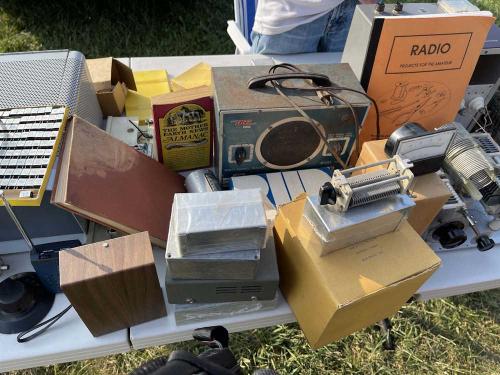
A couple of interesting old tube testers showed up, including this TV-7B/U. It looked used, but in decent shape. Out of my price range, of course.
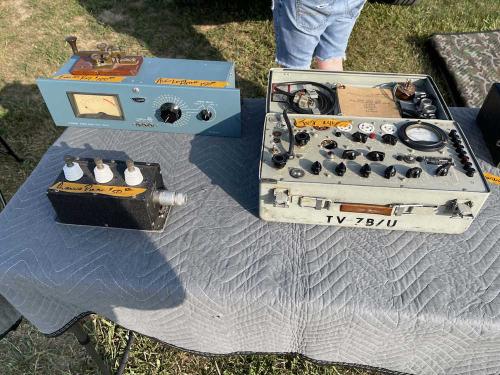
A vendor had some solar panels and an assortment of controllers in a box. Your choice, mix n match.
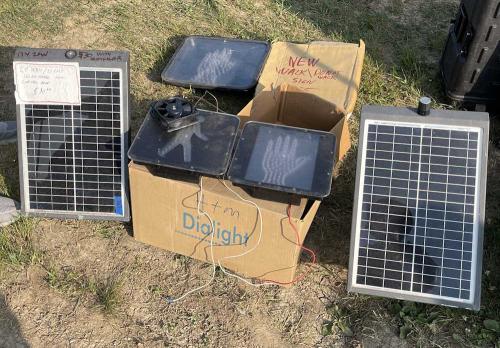
I can’t see this being useful for anything other than a costume prop…
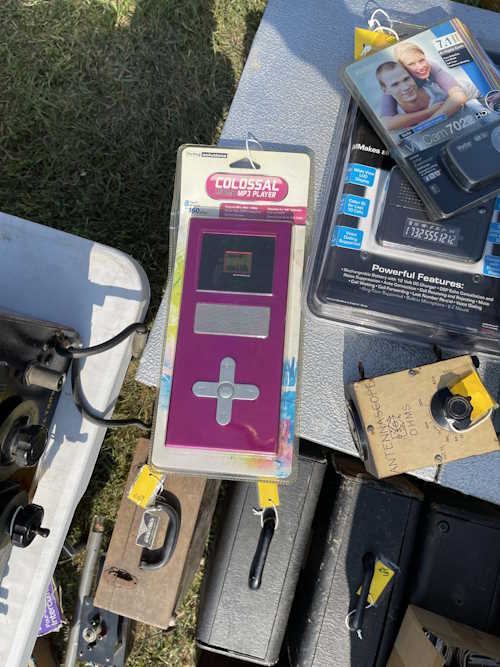
A neat old Hickok signal generator. I can’t use this, but the design is cool and would look good as a movie prop.
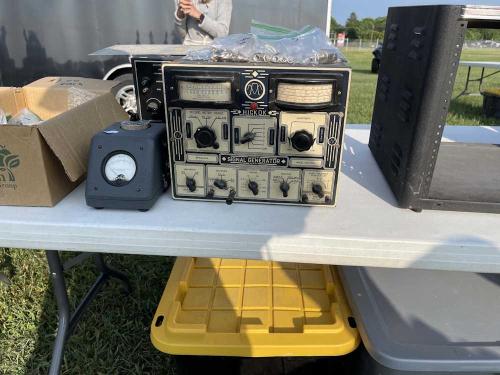
The club had a bunch of stuff they were selling off to raise money for the club. They had these scope carts that were super cheap. These things are super-heavy-duty and were a steal at the price.
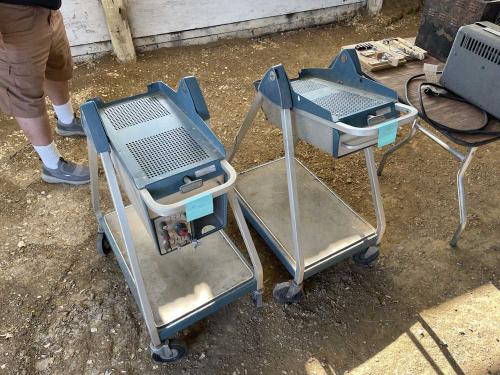
They also had this interesting RCA television for $5. Someone got a steal on this guy.
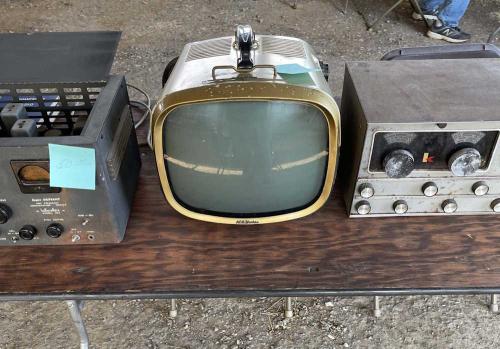
Last thing of the day was this tube tester and audio meter. I wanted to take both, but the roller chart was missing from the tester and the audio analyzer was full of tubes and wood shavings. I left both of them for someone else.
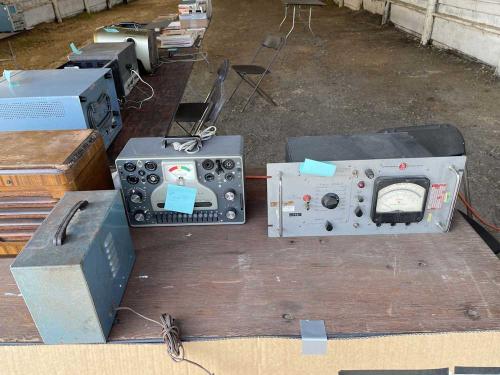
All in all, it was a good show, and there was a lot of things to see. Next week, I’ll be posting about the things that I brought home, and later, a diagnosis of the audio test amp.
Next show is Columbus in August. See you there!
- 2023
- Jun
- 10
Dayton purchase: An HP3440 NIXIE DVM
One of the things I keep an eye out for is NIXIE equipment. I have a few pieces in service, and as these devices age they are getting harder to find. People such as myself buy them for parts and spares, and godless heathens destroy them for the tubes so as to build clocks. It’s not uncommon to find an empty chassis where all the boards were discarded when the tubes were removed.
Fortunately, this wasn’t one of those. Cosmetically, it was in ok shape. Covers were all present, feet and bail were there, it looked it’s age. Wood screws holding the bottom cover on suggested someone had been in it and lost parts, so that was taken into account. The vendor said that it worked, but examination and experience said it probably didn’t. I was right.
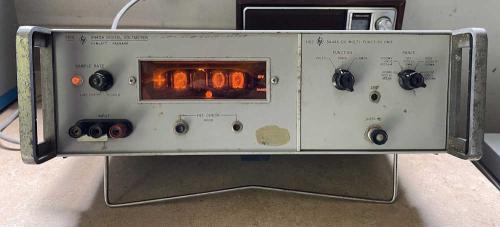
The aforementioned screws told a story that someone had probably opened it, let it set, and someone else hastily tied it up for sale. It had several non-factory features installed, including both the clogged-with-mud input terminals, and the rust-onna-nut package for the plug-in module. This thing probably sat in a barn or garage for a while.
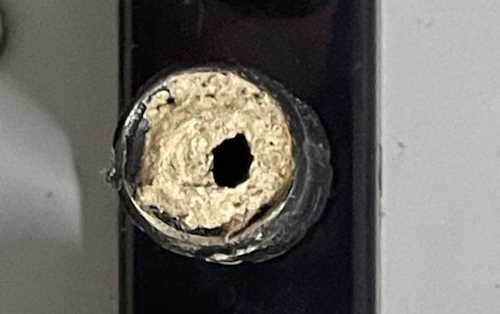
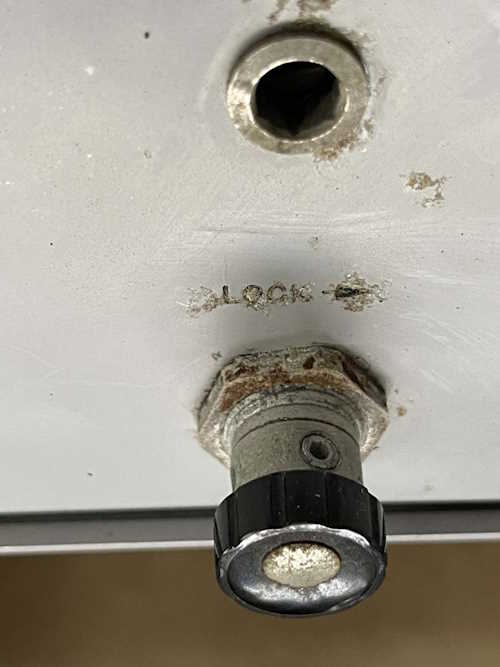
As Shango066 says, the first thing you do is look at the device thoroughly to note anything unusual. The inside had several things to see. The device had about the level of dirt I’d expect, although it’s not really that old for one of these units. Date codes on capacitors suggested this had been made (or repaired) at some point in the early 80s. That it didn’t have ICs for the driver cards suggests it’s not one of the last ones, but it’s getting close.
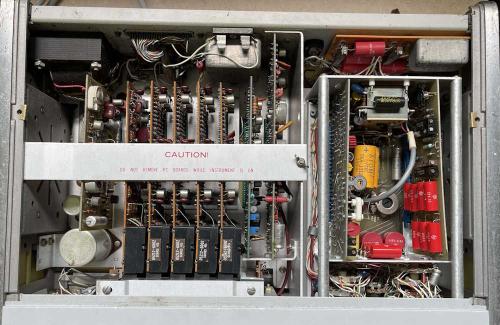
The first thing of note was the missing fuse at the top of the device. This wasn’t as much of a concern as you’d think, as it fed the recorder output instead of being a fuse for one of the power supplies.
The plugin module had some interesting things going on as well. One of the cards was not seated properly in it’s slot - this could be from vibration or other mechanical stress, so that was simply a matter of pulling it out and re-seating it properly. The card was slightly warped, so it had been like that for some time.
The most interesting thing here was the two orange dry electrolytics in the middle of the module. This most certainly isn’t factory, and as they were just hanging loose and kind of tied together. It’s pretty obvious this isn’t a factory part - if you hadn’t guessed that already.
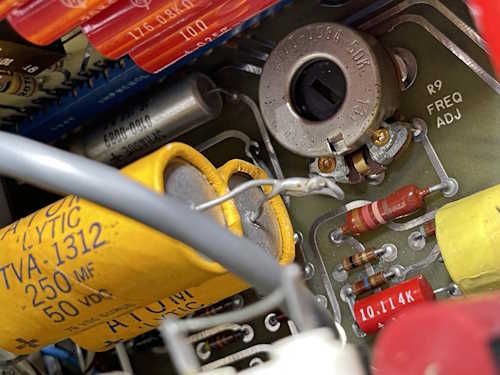
I don’t know that you could get that style of capacitor in the 80s, so those may have been hanging around in someone’s parts bin, or may have even been rescued from an old television set before making their way into this device. If I plan on putting this module into service in one of my other devices, it will need to be repaired correctly.
Note the ultra-precision resistors present in this module. 10.114k (!)
The bottom wasn’t as bad, but still showed some work.
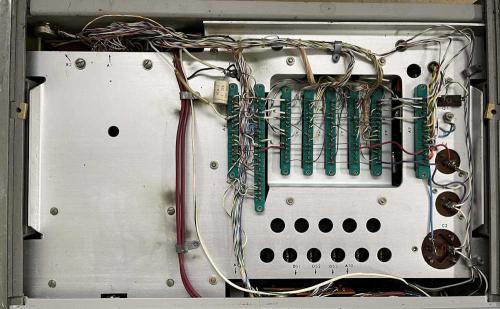
There was some dirt along the wires indicating it had been in use for quite some time, and one of the clamps was broken. I’m not sure if this was due to age or someone moving wires frequently, but it’s not that big of an issue. The big takeaway here is the rat’s nest in the upper left hand corner of the unit. The string ties had all been removed and this bundle had been poked at numerous times. Nothing was broken or showed signs of insulation damage, so I ignored it and moved on.
So…what’s actually wrong with this unit? As you can see from the first picture, almost all of the tubes light up. The second numeric tube has some bad segments, but that’s to be expected. This unit simply didn’t DVM. Normally, the neon lamp to the left will flash, one flash per read. This one did not, it was like it was in hold mode. You could mess with the 8000 button, and the sample rate control to get it to manually change, but it was not performing those reads automatically like it should.
Often times, that will be because the cards are in need of an edge cleaning, so I decided to do that. You simply pull the card, clean the fingers with a pencil eraser, make sure it free of debris, and re-insert. I have to do this to most of my units once a year or so.
This is the power supply card. Notice that there’s been a lot of repair to the unit, as evidenced by the flux-coated joints. This is not how HP would have left anything from the factory. There’s also a bit of corrosion on some of the larger joints, as evidenced by the darkened solder. This has been exposed to some dampness at some point in it’s life.
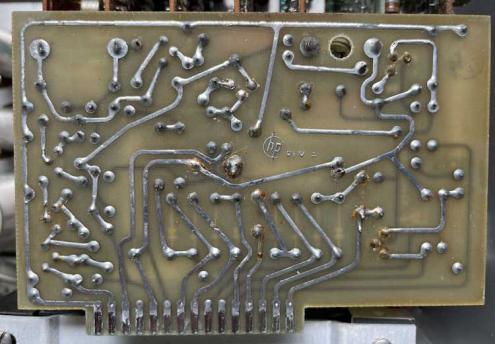
The fingers weren’t that bad, normally they exhibit marks where they’ve been placed and removed multiple times. This may have just been out a few times. Power supply is operational, so nothing to do here other than clean and replace.
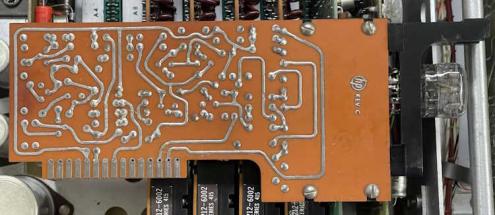
This is one of the NIXIE driver cards. The fingers on this didn’t indicate any removal, and none of these cards showed any repairs.
How does this work? These are an up-counter with a wheatstone bridge. One of the bridge sides is a ramp voltage, another side is the unknown input. The ramp voltage increases and the cards count up, when the bridge becomes balanced the unit stops counting and displays the unknown input on the tubes. Of particular note is how HP decoded the output - the black “socket” for the tube contains a photoconductive plate with neon bulbs driven by the flip-flops on the card. Depending on what sequence of bulbs is lit, certain parts of the photoconductive plate are active and drive the segments of the display tube. It’s fascinating how they did that and is worth a paper of it’s own. Maybe for a future post?
Here’s the card that’s most likely the problem. The ramp generator. It had marks on the fingers indicating this had been in and out of it’s socket many times. It, for some reason, also had a lot of bug debris on it. Only this card hard that, so I wonder if this was pulled from another unit originally - usually when insects get into a device like this, their crap is all over the thing.
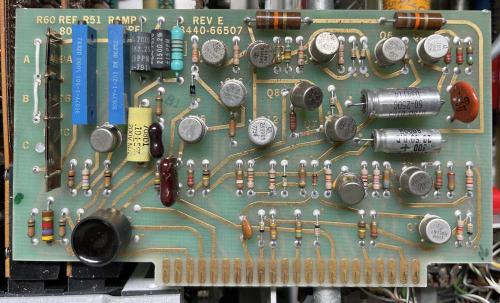
If you look closely, Q8 right in the middle of the card has been lifted as if someone was troubleshooting the device before I got it. So this is indeed the problem (probably!) and if I wanted to fix the device, I’d start here.
But, that’s the thing. I bought this knowing that it probably didn’t work due to the condition of the unit. It was purchased solely for parts, and parts it is. I’m not sure how much time I want to spend on this, but who knows. I may have a spare ramp card in my box ‘o junk, as I’ve purchased these units before in tear-down condition. I might wait until the snow flies and dig that box of cards out of storage and see what’s in there.
Until then, this unit is going to serve it’s function of being a parts donor for my other units.
Stay tuned, next week there’s one more show’s worth of pictures to post until late summer. The Butler Breezeshooter’s hamfest was a nice show, and I brought home stuff I didn’t need. As usual!
- 2023
- Jun
- 3
Dayton 2023: Stuff I drug home.
I made good on my promise to not drag home too much junk this year, but a few boat anchors did manage to make their way in my car. Both of them had an immediate use, but the one that was going to go in to the rack didn’t work. Not a big deal, but still…it gives me a chance to re-engineer some stuff. The rest of the items were parts for later use, whenever the need arises.
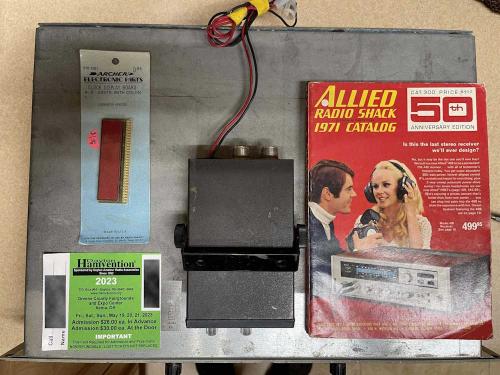
Just some random bits I picked up. An old LED display (made in the USA!) from Rat Shack, and a 1971 Allied/Radio Shack catalog. The catalog is fascinating, the prices that some of the things cost was incredible, and it’s interesting seeing some of the Shack’s staples like the Weather Cube. It’s fun to look through it and see things I wish I could still buy.
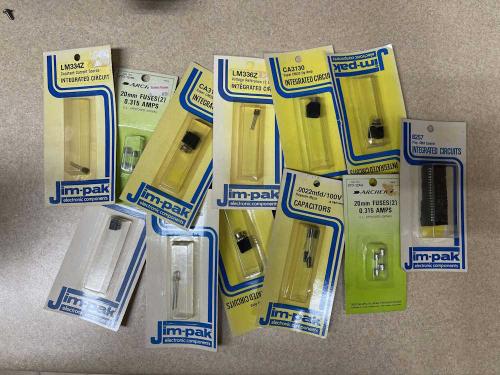
A vendor was selling older Jim-Pak parts, as well as a handful of things from other vendors. Some were $1 per, others were 2 or 4 per $1. I picked a selection of parts, as well as some of those oddball fuses old meters used for their current sections.

This is a unit that was meant to monitor the audio feeds in a studio. At it’s heart, it’s two “channels” with a center channel. Unfortunately, it didn’t work. Examination reveals a lot of white corrosion on the input board, and it looks like some water was spilled and lay on the board for a long period of time. That’s not really a big deal, I’m thinking a couple of LM386 ICs can fix this guy right up. I’m not interested in studio accuracy, I want something for my rack that I can connect to the plugboard for audio testing.
2025: it’s going to auction at a local club.
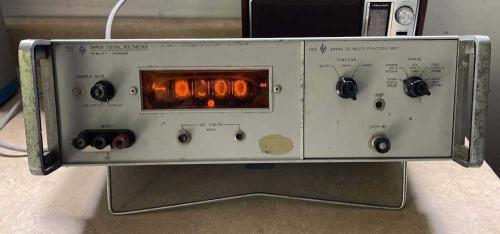
According to the vendor, this works. Well…it didn’t. Mostly. I picked it up for parts since many of these are being torn down for the displays so they can become clocks. :( The device itself had a hard life, evidenced by the replacement screws in the bottom and the considerable cosmetic damage to the unit itself. It had all of it’s feet and bail, so that’s quite nice.
An examination on the inside revealed many repairs, some boards that had left their slots, and a missing fuse. Bringing the device up on power revealed that it indeed did not work, the master clock was not present so the device wouldn’t sample. One of the tubes was also partially bad, but it had the incredibly rare polarity indicating tube, probably worth the price of the device itself.
While cleaning the card edges I found that the clock card had a transistor leg lifted, so someone was troubleshooting the device when it was put aside. As this was supposed to be a parts unit, I’m not sure how far I want to go fixing it - if at all - but it will be the subject of a future post detailing the examination.
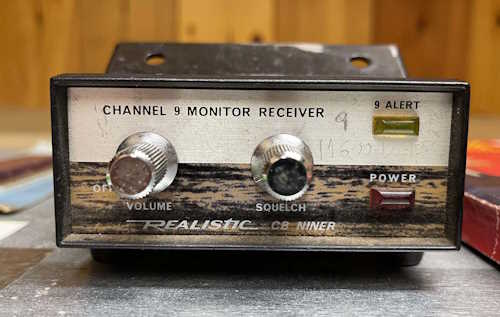
This is one of Radio Shack’s oddball devices from the CB radio era. It’s a crystal-controlled device that listens to Channel 9, which was commonly used as the emergency channel It was designed for antenna passthrough, and has it’s own speaker. If I can find a schematic for this, I may see if I can re-tune it to Channel 19, since there’s still a little activity there.
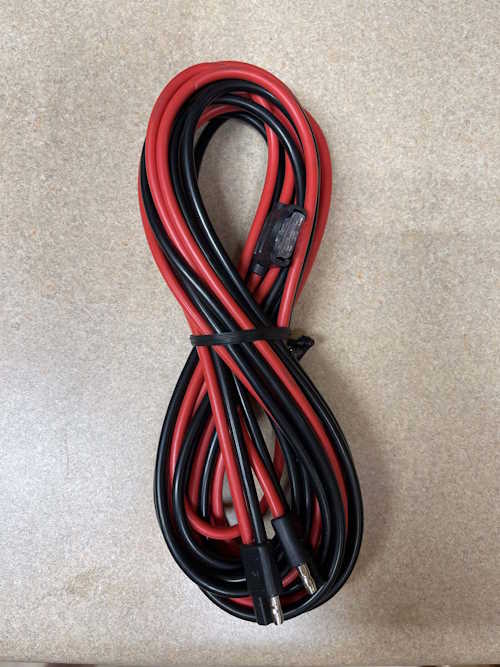
A friend of mine said he wanted a 2-pin cable for a battery box project he made. Said he needed an extension, so I found this. It’s not going to get warm anytime soon.

This was a CB-era piece in the bins with the Jim-Pack parts. I don’t know why I got this other than it’s funny. Rip-off characters, anyone?
The slim haul wasn’t because I didn’t see things I wanted. I did. A lot of it. There were a couple of pieces that I saw that I wanted to bring home, but didn’t have a need for - a WWV receiver and some other devices among them. I figured if they were there Sunday, I’d bargain, but they weren’t. That’s me being told that I don’t need them, leave them where you found them.
(But you know very well if I see that receiver again I may pick it up because I’m being told it’s still here so you know you want it!)
Overall, I think I got some good stuff. The meter may make an interesting project, should I decide to repair it, but I think it’s just parts with a good plug-in for my other devices.
Next show is Butler, PA, and then nothing for a few month. Stay tuned for some show posts from that one, and some detail posts on a few of the devices I’ve picked up over the last year.
- 2023
- Jun
- 2
The Columbus (OH) Hamfest - August 5th 2023.
Our local Hamfest is happening Saturday, August 5th this year. This one is usually well worth the short trip and $5 admission price.
Columbus Hamfest
ALADDIN SHRINE CENTER
1801 Gateway Circle
Grove City, Ohio 43123
Saturday, August 5th 2023
8A-1P
